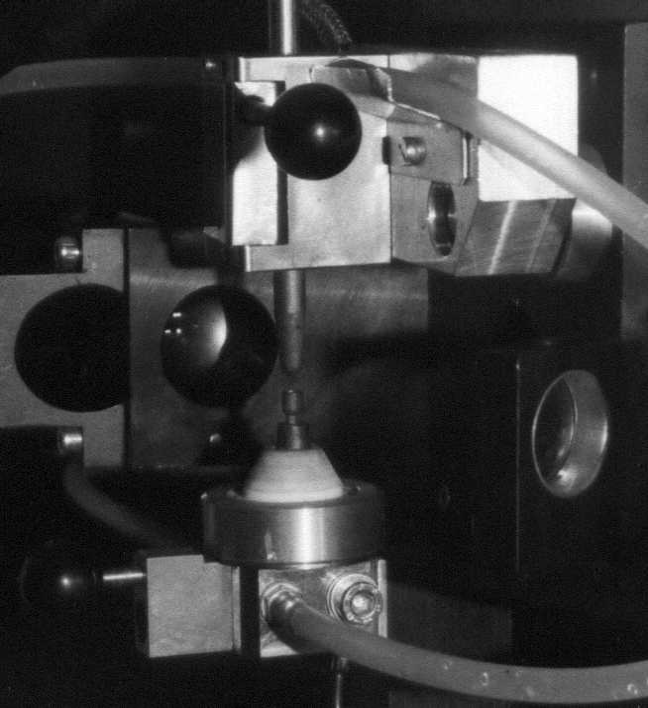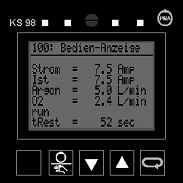
|
|
|
|
|

dc-Arc System DCA-301
The system DCA-301 is an autarkic excitation-unit for the coupling with optical emission-spectrometers by a flexible UV quartz fibre optic.
Description:
In a desktop-housing with the dimensions 68x68x64 cm there are quick-change electrode holders that can be adjusted from the outside, also a special optics in 90-degree-configuration (for the suppression of the arcs fluctuations), the electronic gas control for argon and reaction-gas (option), a power-supply of about 1.5 to 30 Amps in a fast and modern solid-state-technology and the ignition-unit. In the front door there is a focusing screen on which the electrode-gap is being viewed by a projection-optic to be controlled and adjusted from the outside while operation. The lower electrode-holder - optional also the upper one - is adjustable from the outside; both are water-cooled. The lower electrode holder is configured as a Stallwood-nozzle which is designed as a changeable cap.


electrode tripod program-controller
On request a version with a special laminar-nozzle is available. By this or by the
standard-nozzle the arc is burning in a quartz-telescope-tube and is being protected from
the atmosphere by a shielding- resp. reaction- gas-stream. So the formation of disturbing
Cyan-bands is being suppressed and the arc is being stabilised. As a standard the system DCA-301 comes equipped for electrodes with
a diameter of 6 - 6,3 mm, other diameters on request.
The arc-current is program-controlled by arbitrary
current-ramps and constant levels. In the same way up to two process-gases (e.g. argon and
oxygen) are electronically controlled.
Application example: trace analysis in river sediments
Analysis-time ca. 150 sec, weight 5 mg
LODs (in the solid sample!): 0,05 to 6 ppm, RSD: 3 to10% (at suitable homogeneity)
The control and programming is being done by a microprocessor-unit KS-98 with graphical LCD-display. Software-languages: German, English or French.
By this the instrument is completely autarkic. In the best case a start/stop-signal is provided respectively processed by the spectrometer. The interface for the communication is standard and may be configured to customers demands. By the four-key-operation the microprocessor-control-unit is to be handled comfortable and easy. On request a telephone-modem-interface for remote-service is available.
The system DCA-301 contains the arcside-optics as well as a UV-stabilized quartz fibre bundle of one meter length with adapter for the spectrometer. The double optics (90° angle) compensates the movements of the arc along the edge of the electrode and hereby to a certain extent the fluctuations in intensity that can be observed in conventional systems.
Furtheron by the optimum mixture of the single fibres the light at the exit of the fibre optics bundle towards the spectrometer is being homogenised. The shape of the exit area can also easily be adapted to the shape of the entrance slit of the spectrometer on request. Standard is a round shape.
A special adapter-optics for the spectrometer is normally not necessary but of course can also be supplied according to customers specifications. So on some CCD-spetrometers it may be helpful to have special filters that are lowering the intensity in the visual section.
In most ICP-spectrometers the whole torch can very
easily be exchanged. In this case the conversion to direct solid sample analysis by dc-arc
becomes most simple: the torch is just being exchanged against a fibre-optics-adapter and
analysis just can go on.

Example for a fibre-optics-adapter: torch of the CID-ICP-spectrometer TJA-"IRIS" (Thermo Electron Corp., left)
and adapter containing the end of the fibre optics (right)
Requirements for the spectrometer:
For best method-development and evaluation of the transient signals the spectrometer software should allow the possibility of record time-resolved signals (intensity against time) the setting of integration-windows.
Options, accessories, consumables:
| description | part.-no. |
|---|---|
| DCA-301, basic version | B30-1-000 |
|
|
|